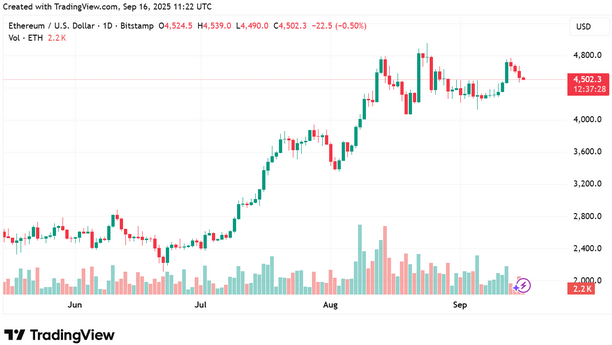Ethereum Will Dominate the Coming Tokenization Era, According to Standard Chartered
The bank projects that the market for tokenized real-world assets (RWAs) — excluding stablecoins — could balloon to $2 trillion within three years, up from just $35 billion today.
If the forecast holds, tokenization would become one of the fastest-growing sectors in modern finance, rivaling the early days of ETFs and digital payments combined.
The Quiet Foundation Laid by Stablecoins
The revolution, Standard Chartered argues, began not with stocks or bonds but with stablecoins — the simple, fiat-backed tokens that quietly built a bridge between crypto and the traditional banking world. Stablecoins created the liquidity, trust, and user familiarity necessary for money-market funds, equities, and corporate instruments to follow.
“The infrastructure is already in place,” noted Geoffrey Kendrick, the bank’s head of digital assets research. “Stablecoins proved the concept — now everything else can move on-chain.”
Ethereum’s Enduring Grip
While dozens of new networks have promised faster or cheaper settlement, the bank believes that the coming wave of institutional tokenization will take place largely on Ethereum, the chain Kendrick calls “battle-tested and boring — exactly what capital markets need.”
Ethereum’s reliability, with over a decade of uninterrupted uptime, makes it a safe foundation for global settlement systems. “Speed is nice,” Kendrick wrote, “but trust is essential.”
The Shape of a $2 Trillion Market
Standard Chartered’s projections divide the future ecosystem into four major categories. Roughly $750 billion each could come from tokenized money-market funds and publicly listed equities, both driven by demand for faster settlement and improved transparency. Another $500 billion would be spread across tokenized investment funds, real estate, commodities, private credit, and other traditionally illiquid assets.
Such a transition would effectively transform blockchain networks into digital capital markets, where trading, custody, and clearing occur in real time.
READ MORE:
USDC Emerges as Tether’s Biggest Threat as Regulation Rewrites the Stablecoin Market
DeFi’s Second Act
Kendrick’s report frames this surge as DeFi’s true moment of convergence with traditional finance. For years, decentralized finance revolved around crypto-native activities — lending, staking, and speculation. But the rise of tokenized assets may now give it a much broader purpose.
“When you can trade tokenized corporate bonds on a decentralized exchange, DeFi stops being an experiment and starts being infrastructure,” Kendrick observed.
He added that the sector is already entering a self-sustaining phase where liquidity attracts new products, and new products attract more liquidity — a dynamic that could mirror the growth flywheel that propelled early financial derivatives.
Regulation Finally Catches Up
Much of this optimism rests on recent legislative progress in the United States. The GENIUS Act, passed in 2025, provided long-sought clarity for stablecoin issuers, unlocking institutional adoption. The upcoming Digital Asset Market Clarity Act — expected by early 2026 — could extend that certainty to broader asset classes.
If regulators like the SEC and CFTC align their frameworks with the bill’s intent, tokenization could shift from a fringe innovation to a pillar of global finance. The only potential obstacle, Kendrick warned, would be a political stalemate preventing regulatory implementation before the 2026 midterm elections.
From Concept to Core Infrastructure
In Standard Chartered’s view, tokenization is not just another blockchain narrative — it’s the next stage of financial modernization. What stablecoins did for payments, tokenized RWAs could do for investment markets: eliminate settlement friction, expand access, and dissolve the borders of traditional finance.
As Kendrick put it: “Stablecoins opened the door. Tokenization will rebuild the house.”
The information provided in this article is for educational purposes only and does not constitute financial, investment, or trading advice. Coindoo.com does not endorse or recommend any specific investment strategy or cryptocurrency. Always conduct your own research and consult with a licensed financial advisor before making any investment decisions.
The post Ethereum Will Dominate the Coming Tokenization Era, According to Standard Chartered appeared first on Coindoo.
You May Also Like

Australia’s ASIC cuts compliance burden for stablecoin intermediaries

Ethereum Price Prediction: ETH Targets $10,000 In 2026 But Layer Brett Could Reach $1 From $0.0058
